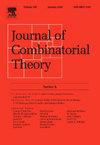Proof of Lew's conjecture on the spectral gaps of simplicial complexes
IF 1.2
2区 数学
Q2 MATHEMATICS
引用次数: 0
Abstract
As a generalization of graph Laplacians to higher dimensions, the combinatorial Laplacians of simplicial complexes have garnered increasing attention. Let X be a simplicial complex on n vertices, and let denote the set of all k-dimensional simplices of X. The k-th spectral gap is the smallest eigenvalue of the reduced k-dimensional Laplacian of X. For any , Lew (2020) [24] established a lower bound for : where and d denote the degree of σ in X and the maximal dimension of a missing face of X, respectively. In this paper, we identify the unique simplicial complex that achieves the lower bound of the k-th spectral gap, , for some k, thereby confirming a conjecture proposed by Lew.
卢关于简单配合物谱隙猜想的证明
单纯复形的组合拉普拉斯算子作为图拉普拉斯算子在高维上的推广,越来越受到人们的关注。设X是有n个顶点的简单复形,设X(k)表示X的所有k维简单形的集合。第k个谱间隙μk(X)是X的k维拉普拉斯约简的最小特征值。对于任意k≥- 1,Lew(2020)[24]建立了μk(X)的下界:μk(X)≥(d+1)(minσ∈X(k)∑degX (σ)+k+1)−dn≥(d+1)(k+1)−dn,其中degX (σ)和d分别表示X中σ的阶数和X缺失面的最大维数。在本文中,我们确定了唯一的简单配合物,它达到k的第k谱间隙的下界,(d+1)(k+1)−dn,从而证实了Lew提出的一个猜想。
本文章由计算机程序翻译,如有差异,请以英文原文为准。
求助全文
约1分钟内获得全文
求助全文
来源期刊
CiteScore
2.90
自引率
9.10%
发文量
94
审稿时长
12 months
期刊介绍:
The Journal of Combinatorial Theory publishes original mathematical research concerned with theoretical and physical aspects of the study of finite and discrete structures in all branches of science. Series A is concerned primarily with structures, designs, and applications of combinatorics and is a valuable tool for mathematicians and computer scientists.

 求助内容:
求助内容: 应助结果提醒方式:
应助结果提醒方式:


